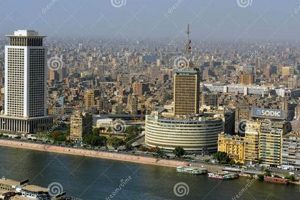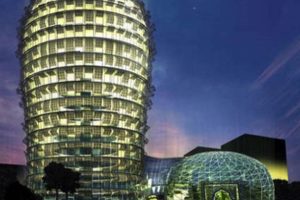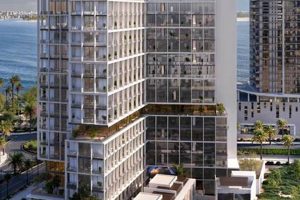Singapore is a city-state located in Southeast Asia. It is known for its skyscrapers, which are some of the tallest in the world. The city has a skyline that is constantly evolving, with new skyscrapers being built all the time.
There are many reasons why Singapore has so many skyscrapers. One reason is that the city has a limited amount of land. This means that buildings need to be built up instead of out. Another reason is that Singapore is a major financial center. Many of the skyscrapers in the city are home to banks, investment firms, and other businesses.
The skyscrapers in Singapore are not just a symbol of the city’s wealth and power. They are also a testament to the city’s engineering and architectural prowess. Many of the skyscrapers in Singapore are designed by world-renowned architects, and they feature cutting-edge construction techniques.
1. Height
Height is one of the most important aspects of skyscrapers in Singapore. The height of a skyscraper is determined by a number of factors, including the city’s building codes, the availability of land, and the desired views from the building. In Singapore, the building codes limit the height of buildings to 280 meters. This is to ensure that the buildings do not interfere with air traffic and to maintain a consistent skyline.
The availability of land is another factor that affects the height of skyscrapers in Singapore. Singapore is a small island nation, and land is scarce. This means that developers must build up instead of out. As a result, many of the skyscrapers in Singapore are very tall.
The desired views from the building are also a factor that affects the height of skyscrapers in Singapore. Many of the skyscrapers in the city are located in the central business district, which offers stunning views of the city skyline and the surrounding harbor. As a result, many of the skyscrapers in Singapore are very tall in order to maximize the views from the building.
The height of skyscrapers in Singapore has a number of practical implications. First, it allows developers to maximize the amount of space available for development. Second, it allows tenants to enjoy stunning views of the city. Third, it helps to create a distinctive skyline for the city.
2. Design
Design is one of the most important aspects of skyscrapers in Singapore. The design of a skyscraper can affect its height, function, and overall impact on the city. In Singapore, skyscrapers are designed to be both functional and aesthetically pleasing. They are also designed to be sustainable and to withstand the city’s tropical climate.
One of the most important design considerations for skyscrapers in Singapore is the building’s height. The height of a skyscraper is determined by a number of factors, including the city’s building codes, the availability of land, and the desired views from the building. In Singapore, the building codes limit the height of buildings to 280 meters. This is to ensure that the buildings do not interfere with air traffic and to maintain a consistent skyline.
Another important design consideration for skyscrapers in Singapore is the building’s function. Skyscrapers in Singapore are used for a variety of purposes, including offices, residential, and retail. The function of the building will determine its design. For example, office buildings will typically have more floors than residential buildings, and they will have larger windows to allow for more natural light. Residential buildings, on the other hand, will typically have more amenities, such as swimming pools ands.
The design of skyscrapers in Singapore is also influenced by the city’s tropical climate. Singapore has a hot and humid climate, so skyscrapers must be designed to withstand the elements. This means that skyscrapers in Singapore are typically built with strong materials and they have features such as sunshades and rain screens to protect them from the sun and rain.
The design of skyscrapers in Singapore has a number of practical implications. First, it allows developers to maximize the amount of space available for development. Second, it allows tenants to enjoy stunning views of the city. Third, it helps to create a distinctive skyline for the city.
3. Architecture
Architecture plays a crucial role in the design and construction of skyscrapers in Singapore. The city’s skyscrapers are known for their innovative and sustainable designs, which reflect the city’s commitment to modernity and environmental consciousness. Here are four key aspects of architecture in relation to skyscrapers in Singapore:
- Facade Design
The facade of a skyscraper is its exterior surface, and it plays a significant role in the building’s overall design and performance. Skyscrapers in Singapore often feature innovative facade designs that incorporate sustainable elements, such as solar panels and green walls. These designs help to reduce the building’s energy consumption and carbon footprint.
- Structural Design
The structural design of a skyscraper is critical to its stability and safety. Skyscrapers in Singapore are typically built with reinforced concrete or steel frames, which provide strength and rigidity to withstand the city’s tropical climate and seismic activity.
- Sustainable Design
Sustainability is a key consideration in the design of skyscrapers in Singapore. Many of the city’s skyscrapers are designed to be energy-efficient and environmentally friendly. They incorporate features such as rainwater harvesting systems, solar panels, and green roofs to reduce their impact on the environment.
- Cultural Influences
The architecture of skyscrapers in Singapore is also influenced by the city’s rich cultural heritage. Many of the city’s skyscrapers incorporate traditional design elements, such as the use of Peranakan tiles and motifs. This reflects the city’s commitment to preserving its cultural identity while embracing modernity.
The architecture of skyscrapers in Singapore is a testament to the city’s commitment to innovation, sustainability, and cultural preservation. The city’s skyscrapers are not only iconic landmarks but also symbols of Singapore’s progress and prosperity.
4. Engineering
Engineering plays a vital role in the design and construction of skyscrapers in Singapore. Skyscrapers are complex structures that require careful planning and executi
on, and engineering expertise is essential to ensure that these buildings are safe, functional, and sustainable.
One of the most important aspects of engineering in skyscrapers is structural engineering. Structural engineers are responsible for designing the building’s framework, which must be able to withstand the forces of gravity, wind, and seismic activity. In Singapore, skyscrapers are typically built with reinforced concrete or steel frames, which provide strength and rigidity. Engineers must also consider the building’s foundation, which must be able to support the weight of the building and transfer the load to the ground.
Another important aspect of engineering in skyscrapers is mechanical engineering. Mechanical engineers are responsible for designing the building’s mechanical systems, such as the heating, ventilation, air conditioning (HVAC), and plumbing systems. These systems are essential for providing a comfortable and healthy environment for the building’s occupants. Engineers must also consider the building’s energy efficiency, and design systems that minimize energy consumption and reduce the building’s carbon footprint.
Electrical engineering is also a critical aspect of skyscrapers. Electrical engineers are responsible for designing the building’s electrical systems, such as the power distribution, lighting, and communications systems. These systems are essential for providing power and connectivity to the building’s occupants. Engineers must also consider the building’s safety, and design systems that minimize the risk of electrical fires and other hazards.
Engineering is essential to the design and construction of skyscrapers in Singapore. By combining their expertise in structural, mechanical, and electrical engineering, engineers ensure that these buildings are safe, functional, and sustainable.
5. Construction
Construction plays a vital role in the development and success of skyscrapers in Singapore. The construction industry in Singapore is highly advanced and efficient, and it has a proven track record of delivering high-quality, world-class buildings. Skyscrapers in Singapore are typically constructed using a combination of reinforced concrete and steel, which provides strength and durability. The construction process is carefully planned and executed, and it involves the use of cutting-edge technology and equipment.
One of the key challenges in the construction of skyscrapers in Singapore is the limited availability of land. Singapore is a small island nation, and land is scarce. This means that developers must be creative in their use of space. Many skyscrapers in Singapore are built on reclaimed land, which is land that has been created by filling in the sea. This requires careful planning and engineering, as the land must be able to support the weight of the building.Another challenge in the construction of skyscrapers in Singapore is the city’s tropical climate. Singapore has a hot and humid climate, which can make it difficult to work on construction projects. Construction crews must take special precautions to protect themselves from the heat and humidity. They must also use materials that are resistant to the elements.
Despite the challenges, the construction industry in Singapore has a proven track record of delivering high-quality, world-class buildings. Skyscrapers in Singapore are among the tallest and most iconic in the world. They are a testament to the skill and expertise of the construction industry in Singapore.
6. Location
The location of skyscrapers in Singapore is a key factor in their design, construction, and overall impact on the city. Skyscrapers are typically built in central business districts or other areas with high land values. This is because land in Singapore is scarce, and developers want to maximize the value of their investment. The location of skyscrapers also affects their views and accessibility. Skyscrapers in Singapore are often built near bodies of water, such as the Singapore River or Marina Bay, which provide stunning views and make the buildings more accessible to visitors and tenants.
- Proximity to transportation
Skyscrapers in Singapore are often located near public transportation hubs, such as MRT stations and bus stops. This makes it easy for tenants and visitors to get to and from the building. Good transportation links also make it easier for businesses to attract and retain employees.
- Access to amenities
Skyscrapers in Singapore are often located near a variety of amenities, such as restaurants, shops, and entertainment venues. This makes it convenient for tenants and visitors to find what they need without having to travel far. Access to amenities also makes the building more attractive to businesses.
- Views and landmarks
The location of skyscrapers in Singapore also affects their views and landmarks. Skyscrapers in the central business district often have views of the city skyline, while skyscrapers in other areas may have views of the sea or other landmarks. The location of a skyscraper can also affect its visibility and prominence in the city.
- Land value
The location of skyscrapers in Singapore is also influenced by land value. Land in Singapore is scarce, and land values are high in the central business district and other desirable areas. This means that developers are willing to pay a premium for land in these areas, which can lead to taller and more expensive skyscrapers.
The location of skyscrapers in Singapore is a complex issue that involves a number of factors, including land value, transportation access, and views. By carefully considering the location of their skyscrapers, developers can create buildings that are both functional and aesthetically pleasing.
7. Function
The function of skyscrapers in Singapore is diverse, ranging from commercial to residential to mixed-use developments. The primary function of a skyscraper is to provide space for people to work, live, and shop. Skyscrapers in Singapore are also used for a variety of other purposes, such as tourism, recreation, and education.
The function of a skyscraper is a key factor in its design and construction. For example, a skyscraper that is designed for commercial use will typically have more floors and larger windows than a skyscraper that is designed for residential use. The function of a skyscraper also affects its location. For example, skyscrapers that are designed for tourism are often located in areas with high visibility and accessibility.
Skyscrapers in Singapore are an important part of the city’s economy and culture. They provide space for businesses to operate and for people to live and work. Skyscrapers in Singapore are also a major tourist attraction, and they help to create a vibrant and dynamic city.
8. Sustainability
Sustainability is a key consideration in the design and construction of skyscrapers in Singa
pore. The city is committed to reducing its environmental impact, and skyscrapers are playing a major role in this effort. Many of the city’s skyscrapers are designed to be energy-efficient and environmentally friendly. They incorporate features such as solar panels, rainwater harvesting systems, and green roofs to reduce their impact on the environment.
One of the most important aspects of sustainability in skyscrapers is energy efficiency. Skyscrapers consume a lot of energy, so it is important to design them to be as energy-efficient as possible. This can be done by using energy-efficient lighting, appliances, and HVAC systems. It can also be done by designing the building to take advantage of natural light and ventilation.
Another important aspect of sustainability in skyscrapers is water conservation. Skyscrapers use a lot of water, so it is important to design them to be water-efficient. This can be done by using low-flow fixtures and appliances. It can also be done by collecting rainwater for irrigation and other non-potable uses.
Green roofs are another important aspect of sustainability in skyscrapers. Green roofs help to insulate the building, which reduces energy consumption. They also help to improve air quality and reduce stormwater runoff.
The sustainability of skyscrapers in Singapore is not just about reducing environmental impact. It is also about creating healthy and comfortable spaces for people to live and work. By incorporating sustainable features into skyscrapers, developers can create buildings that are good for the environment and for the people who use them.
9. Impact
Skyscrapers have a significant impact on the city of Singapore. They are iconic landmarks that shape the city’s skyline and contribute to its reputation as a global metropolis. Skyscrapers also play a major role in the city’s economy, providing space for businesses and workers. In addition, skyscrapers can have a positive impact on the environment by incorporating sustainable design features.
One of the most visible impacts of skyscrapers is their contribution to the city’s skyline. Skyscrapers are often the tallest buildings in a city, and they can be seen from miles around. This makes them iconic landmarks that are easily recognizable. In Singapore, skyscrapers such as the Marina Bay Sands and the One Raffles Place are instantly recognizable and have become symbols of the city.
Skyscrapers also play a major role in the city’s economy. They provide space for businesses and workers, and they can help to attract investment and create jobs. In Singapore, skyscrapers are home to many of the city’s largest banks, financial institutions, and multinational corporations. This makes them a major contributor to the city’s economy.
In addition to their economic impact, skyscrapers can also have a positive impact on the environment. Many skyscrapers in Singapore are designed to be energy-efficient and environmentally friendly. They incorporate features such as solar panels, rainwater harvesting systems, and green roofs to reduce their impact on the environment. This makes them more sustainable and helps to reduce the city’s carbon footprint.
Skyscrapers are a major part of the Singapore cityscape, and they have a significant impact on the city’s economy and environment. By understanding the impact of skyscrapers, we can better plan and design our cities for the future.
FAQs on Skyscrapers in Singapore
Skyscrapers have become an iconic part of the Singapore skyline, but they also raise a number of questions and concerns. Here are some of the most frequently asked questions about skyscrapers in Singapore, answered in a serious and informative tone:
Question 1: Why are there so many skyscrapers in Singapore?
Answer: Singapore is a small island nation with a limited amount of land. This has led to a vertical development strategy, with skyscrapers being built to maximize space and accommodate the city’s growing population and businesses.
Question 2: How tall are the skyscrapers in Singapore?
Answer: The tallest skyscraper in Singapore is the Marina Bay Sands, which stands at 256 meters tall. Other notable skyscrapers in the city include the One Raffles Place, the UOB Plaza, and the Republic Plaza, all of which are over 200 meters tall.
Question 3: Are skyscrapers in Singapore safe?
Answer: Yes, skyscrapers in Singapore are generally considered to be safe. They are built to strict building codes and undergo regular safety inspections. Singapore also has a low rate of seismic activity, which reduces the risk of earthquakes.
Question 4: Are skyscrapers in Singapore sustainable?
Answer: Many skyscrapers in Singapore are designed to be sustainable and environmentally friendly. They incorporate features such as solar panels, rainwater harvesting systems, and green roofs to reduce their impact on the environment.
Question 5: What is the future of skyscrapers in Singapore?
Answer: The future of skyscrapers in Singapore is likely to see a continued focus on sustainability and innovation. New skyscrapers are being designed to be even more energy-efficient and environmentally friendly, and they are also incorporating new technologies such as smart building systems and vertical gardens.
Question 6: How can I visit the skyscrapers in Singapore?
Answer: Many of the skyscrapers in Singapore offer observation decks and other public spaces that allow visitors to enjoy the views from the top. Some of the most popular observation decks include the Sands SkyPark at Marina Bay Sands, the 1-Altitude Observatory at One Raffles Place, and the ION Sky at ION Orchard.
Summary
Skyscrapers in Singapore are a testament to the city’s economic prosperity and architectural prowess. They are also a major tourist attraction, offering stunning views of the city and its surroundings. As Singapore continues to grow and develop, its skyscrapers will undoubtedly continue to evolve, reflecting the city’s ever-changing skyline.
Transition
For more information on skyscrapers in Singapore, please visit the following resources:
- Urban Redevelopment Authority (URA)
- Skyscraper Center
- Emporis
Tips for Visiting Skyscrapers in Singapore
Visiting skyscrapers in Singapore is a great way to experience the city’s stunning skyline and architecture. Here are a few tips to help you make the most of your visit:
Tip 1: Choose the right time to visit.
The best time to visit a skyscraper is during the early morning or late evening, when the light is at its best for taking photos. You’ll also avoid the crowds that tend to gather during the midday hours.
Tip 2: Book your tickets in advance.
Many of the skyscrapers in Singapore offer observation decks and other public spaces that require tickets for entry. It’s a good idea to book your tickets in advance, especially if you’re visiting during peak season.
Tip 3: Dress appropriately.
Most skyscrapers in Singapore have a dress code that requires visitors to dress respectfully. This means avoiding shorts, tank tops, and other casual attire. You should also wear comfortable shoes, as you’ll likely be doing a lot of walking.
Tip 4: Be prepared for security checks.
All visitors to skyscrapers in Singapore must go through security checks before entering. This includes passing through a metal detector and having your bags searched. Please allow extra time for security checks, especially if you’re visiting during peak hours.
Tip 5: Take your time.
Don’t rush your visit to a skyscraper. Take your time to enjoy the views and learn about the building’s architecture and history. Most skyscrapers have exhibits and displays that provide information about the building and its design.
Tip 6: Bring your camera.
The views from the observation decks of skyscrapers in Singapore are breathtaking. Be sure to bring your camera to capture the stunning.
Tip 7: Enjoy the experience.
Visiting a skyscraper in Singapore is a unique and memorable experience. Relax, enjoy the views, and take in the city’s skyline from a whole new perspective.
Summary
By following these tips, you can make the most of your visit to a skyscraper in Singapore. These iconic buildings offer stunning views of the city and its surroundings, and they are a must-see for any visitor to Singapore.
Transition
For more information on visiting skyscrapers in Singapore, please visit the following resources:
- Urban Redevelopment Authority (URA)
- Skyscraper Center
- Emporis
Conclusion
Skyscrapers have become an iconic part of the Singapore skyline, and they play a major role in the city’s economy and culture. They are a testament to the city’s architectural prowess and its commitment to sustainability.
As Singapore continues to grow and develop, its skyscrapers will undoubtedly continue to evolve. New skyscrapers are being designed to be even more energy-efficient and environmentally friendly, and they are also incorporating new technologies such as smart building systems and vertical gardens. The future of skyscrapers in Singapore is bright, and they will continue to be a major part of the city’s skyline for many years to come.







